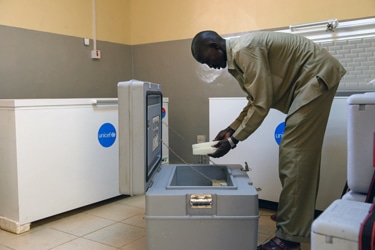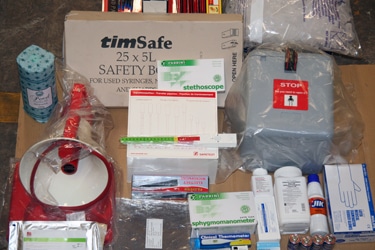HEALTH SYSTEMS STRENGTHENINGtowards Universal Health Coverage (UHC)
A woman receives a tetanus vaccine and a long-lasting insecticidal net (LLIN) at a community health center in Angola. © UNICEF/ ANGA2015-0408/Marcin Suder
A woman receives a tetanus vaccine and a long-lasting insecticidal net (LLIN) at a community health center in Angola. © UNICEF/ ANGA2015-0408/Marcin Suder
The above photo depicts a mother and a baby who are receiving health checks, a tetanus vaccine and a long lasting insecticidal net (LLIN) at a community health center in Angola.
In order to realize this kind of basic health services to be accessible to every child and everyone when needed without a financial burden (=Universal Health Coverage: UHC), timely and appropriate Health information and data system are essential to identify where and how many children and mothers need to be vaccinated; to grasp the status of distribution of bed-nets to prevent Malaria; and to check quality health staff, facilities and services are in place and are equitably accessible for everyone’s use in the community. This health information/data will be the basis as evidence, on which health policies (including budgeting), plans and program actions are implemented by the local and the central governments for their scale-up leading to sustainable health systems.
It is also necessary to strengthen procurement and supply chain management (including cold-chain) to ensure essential drugs and medical equipment are in place and accessible in quality conditions.
Further, capacity-building of human resources in the health sector is essential to manage health information systems, procurement and supply-chain and health system governance (policy development, evaluation, financing and so on).
Therefore, Health Systems Strengthening is a foundation for UHC, corresponding to SDG3.8.
This project aims to facilitate national health systems’ shift from aid-dependency to sustainable self-sufficiency.
The objective of this project is to sustainably strengthen health systems focusing on the following three aspects:
 © UNICEF/UNI148585/Vassie
© UNICEF/UNI148585/Vassie
 © UNICEF/UN070232/Hatcher-Moore
© UNICEF/UN070232/Hatcher-Moore
 © UNICEF/UNI126130/Barongo
© UNICEF/UNI126130/Barongo
Angola, Guinea and Togo. Health indicators, such as child mortality rates, of these countries have been at the lowest levels. But the recent progress and the governments’ commitment are strong; thus, Health Systems Strengthening is timely and equitable, and is needed to push this momentum further. Together, let’s make this happen.
Together, Takeda and UNICEF aim to help protect the lives of an estimated 8.5 million people including 1.6 million children under five and 424,000 pregnant women.
| Number of beneficiaries in Angola (Target) | ||||||
|---|---|---|---|---|---|---|
| Beneficiaries | Decentralized level | Number | Populations | Pregnant women |
Children 0-59 months |
Children 0-11 months |
| Direct | Local municipalities (districts) |
15 | 6,818,757 | 350,143 | 1,351,554 | 293,206 |
| Indirect | Provinces | 4 | 11,168,743 | 573,515 | 2,450,054 | 480,256 |
| Number of beneficiaries in Guinea (Target) | ||||||
|---|---|---|---|---|---|---|
| Beneficiaries | Decentralized level | Number | Populations | Pregnant women |
Children 0-59 months |
Children 0-11 months |
| Direct | Local municipalities | 10 | 241,171 | 9,646 | 41,000 | 8,440 |
| Indirect | Districts / prefectures | 9 | 2,549,888 | 101,995 | 433,480 | 89,246 |
| Number of beneficiaries in Togo (Target) | ||||||
|---|---|---|---|---|---|---|
| Beneficiaries | Decentralized level | Number | Populations | Pregnant women |
Children 0-59 months |
Children 0-11 months |
| Direct | Local municipalities in the two regions |
203 | 1,457,000 | 65,000 | 255,000 | 60,000 |
| Indirect* | Local municipalities in the two regions |
12 | 418,000 | 18,800 | 73,100 | 17,300 |
*The numbers of “Indirect” beneficiaries in Togo don’t include those of “Direct” beneficiaries.